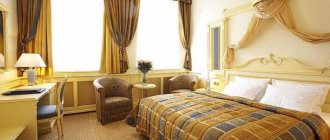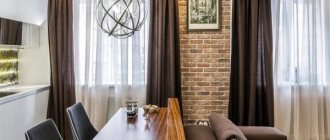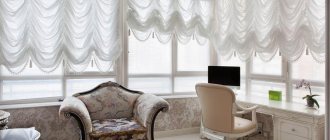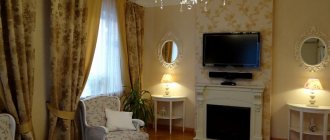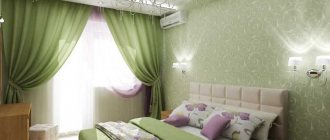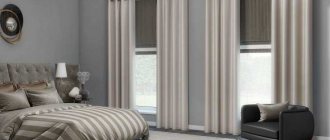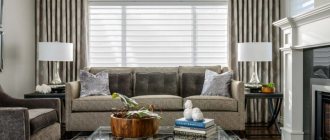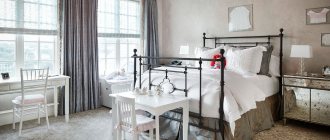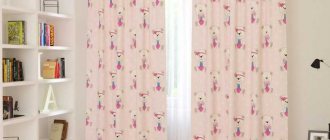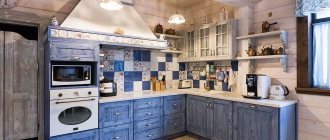Style specifics
Provence personifies the sophistication and simplicity of the French province. It may be different, but you can always trace the common features. The expressiveness of the finished interiors makes them recognizable to everyone.
Pastel colors, soft and restrained shapes, the naturalness of the materials used, simple floral and plant patterns, a variety of decorative elements - all these are signs of Provence.
The style values hand-made products, as a result of which it welcomes hand-embroidered curtains, hand-made tiebacks, carved cornices and forged decor.
Drawings
Choose images on the fabric depending on the dimensions of the room (the smaller the room, the smaller the pattern should be) and the design of the room:
- Combine the design on the fabric with furniture finishing and other textiles (towels, tablecloths, capes, furniture upholstery).
- Floral motifs go perfectly with plain walls.
- Choose plain window textiles if the wallpaper has patterns or designs.
- As a design option, combine patterned fabrics with plain fabrics. This way you can “dilute” the rich print of the fabric.
Provence curtain design
Provencal textile decor should not stand out from the overall picture of the interior. When decorating curtains, use additional decorations: frills, folds, ruffles, ribbons enhance the romantic atmosphere in the kitchen. Even the simplest cut can be embellished with these decorative elements.
Linen fabric drapes little, but after careful ironing it retains its shape for a long time. Semi-synthetic fabrics that imitate linen have excellent drapery and are well suited for sliding curtains and cafe curtains.
We also recommend: Hanging curtains correctly and beautifully - 13 important steps, tips and tricks
Linen curtains for the kitchen in the Provence style are an excellent option for practical curtains that emphasize the naturalness and simplicity of the furnishings and fabric window decorations characteristic of this style. Plain linen fabric can be decorated with beautiful stylish embroidery. Linen fabrics will look great in roman and roll patterns.
Cornices, types of fastening curtains in the Provence style
Cornices and fittings for fastening play their role in creating this Provencal style.
The methods for attaching Provencal curtains in the kitchen are simple:
- Cornices. Typical models are wooden or imitating wood. There are many varieties. Metal cornices - simple and vintage, with ornate tips - look good and do not violate the rules of style.
- Hooks. The base is a cornice with strung hooks. This type of fastening is as close as possible to the rural one, giving the design simplicity, restraint and originality.
- Wooden and metal clothespins attached to wooden and metal rings are strung on a cornice.
- The loops are made from curtain material. They are attached to a stretched fishing line or a round cornice. They look good on a window opening, as well as open cabinets and shelves.
- Drawstring - this fastening method is used most often. It is a strip of fabric stitched on the back side of the top of the curtain in the form of a “tunnel” into which a cornice, fishing line, and cord are threaded. By moving the curtain fabric, you can gather it into folds.
- The cornice can be replaced with a stretched line (for tulle curtains), which echoes the rural simplicity of the style.
So, curtains in the Provence style will decorate your kitchen and dining room, making the design of the room unique, incorporating natural motifs into the decor. Curtains in the style of the French countryside are still relevant today; they look original and harmonious on kitchen windows. The models of such curtains are simple in shape and do-it-yourself - you can sew them yourself without any problems. Variability is one of their key advantages. This style gives the greatest opportunity for imagination in decorating the kitchen - a room loved by the whole family.
Types of curtains for Provence
Since in Provence the emphasis is on the texture, color and design of the fabric, it is allowed to use most of the types of curtains offered by manufacturers.
Floor finishing
When decorating a balcony in Provence style, the floors can be made of wood (the best option) or ceramic tiles. Let's consider the option of floors made of tongue-and-groove boards 20–25 mm thick, logs made of beams 30×40 mm.
Step 1. Calculate the required amount of material. It is recommended to lay boards on the floor along the balcony, this improves the appearance of the room. For insulation, take foam boards or mineral wool (can be rolled or pressed).
Practical advice. To avoid waterproofing between the joists and the concrete slab, you can fix them on metal angles. With their help, by the way, it is easy to align the horizontal position of all the logs - the angles have special technological longitudinal slots.
Step 2. Mark the location of the joists, drill holes in the slab and secure the angles. Make sure that they are all located on the same line.
Step 3. Secure the two outermost logs and align them horizontally.
Step 4. Fix all other logs along the marked lines. Linearity can be controlled with a long, level staff. Make sure that there is a gap of several millimeters between the bottom surface of the lumber and the concrete slab.
Lag mounting option
Step 5. Install insulation between the joists. Again we recommend using foam. No one spends much time on the balcony, so there is no need to be afraid of harmful fumes, especially since there are modern brands of completely safe polystyrene foam available. If you are afraid, insulate the floor with mineral wool. But it must be covered with a waterproofing layer. You can use non-woven materials, but ordinary polyethylene film will also work.
Penofol flooring
Step 6: Start laying the boards. In order not to damage the insulation layer, we recommend laying a subfloor on the joists using scraps of plywood, OSB or boards. As the finished floor is completed, the rough floor is removed. As soon as the new floor becomes large enough in area, move on to it and completely remove the subfloor. We have already mentioned that there is no need to pull the floor boards tightly; this is “required” by the Provence style.
Laying floor boards
Flooring installation
Balcony floor finishing
Step 7: Once the perimeter floorboards are installed, nail the baseboards.
Step 8. Thoroughly clean the floor from dust and cover it with high-quality wear-resistant varnish. It is better to apply the varnish with a brush; a roller does not provide the necessary rubbing. The more layers, the smoother the floor surface, but the layers must be made thin.
Applying varnish to a wooden floor
Each subsequent layer is applied after the previous one has dried in a perpendicular direction. It is not recommended to impregnate lumber with stains before varnishing; the boards should have a natural color and texture.
Prices for various types of wood varnishes
Wood varnish
Roman curtains
An ideal choice for a small space. Advantages: tight fit to the glass, high-quality protection from sunlight, compactness.
Country styles for a room on the balcony
The style of an Alpine chalet and a Provencal house is often summarized by one term - “country” (“village”). This is not unreasonable, because the principles of decorating living rooms in this case are similar. But there are also a number of fundamental differences.
Rusticism in loggia design
What characterizes a village? Remoteness from the city and many benefits of civilization, closeness to nature, simplicity of life, where almost everything is done with your own hands. Hence the specific features of country styles with reference to a specific area and culture.
This is the predominance of natural materials. Plastic and chrome are strictly prohibited! If we talk about finishing, then the materials should show handicraft, independence in performing the work, and inexperience. This is expressed in chaotic strokes, uneven seams when laying stone, and unpainted areas.
Don’t be afraid to apply ideas for decorating large rooms for balconies with some adjustments.
Colors should be natural. These are shades suggested by the nature of the chosen region and the characteristics of its climate.
It is better to choose furniture that is practical, dimensional, and as simple as possible. Clear lines, almost complete absence of decor, deliberate roughness in execution - classic country furniture.
Country furniture
Taking into account the area of the loggia, the choice should fall on the most necessary products that correspond to the purpose of the room.
Even a small country-style balcony always has an abundance of fabrics and decor. In most cases, it is traditional in nature, reflecting national or local affiliation.
Balcony in Provence style - French country
The proximity of Provence to the sea determined the palette of the style of the same name. These are sand, blue, blue, shades of brown, olive, the color of spring grass, milky. It is better to avoid bright accents. In extreme cases, it can be rich blue or green.
Characteristic range
Provence pleases the eye:
- An abundance of fresh flowers. Pots, handmade cache-pots, and explanatory inscriptions on them are welcome.
- Symbols in the form of sunflowers, lavender, roosters. They are embroidered and depicted on dishes and cutting boards.
- An abundance of loose textiles. Fringe, ruffles, and braiding are acceptable.
- Furniture can be made of solid wood, forged, or wicker. With a claim to elegance.
Recognizable Provence decor
Provencal style is one of the most beloved by designers. It does not require large investments, is suitable even for the smallest balconies, and gives an amazing feeling of comfort and unity with nature.
The charm of Provence lies in its simplicity
Alpine chalet – when you want to go to the mountains
The chalet is associated with mountains, blinding snow-white slopes, and endlessly tall trees. Living even on the ground floor, you can bring yourself closer to such an idyllic picture by decorating your balcony accordingly.
Unlike Provence, the colors here are darker, the palette is based on contrast. You should start from the numerous brown shades of natural wood and the white color of snow. Color accents can be made using terracotta and red.
The main materials are plaster, wood, stone. Rough, preferably without additional coating. However, to extend the service life, you can use matte varnish.
Chalet style
Alpine motifs are typical. These are images of snow-capped peaks, mountain landscapes, animals, and vegetation. They are appropriate on fabrics, in the form of paintings in a rough frame, or in carved decor. Animal figurines, simple geometric clay vases, and animal skins as a carpet create coziness.
Curtains-cafe
This is the best option for those who love non-standard solutions. Here the cornice is installed right in the middle of the window opening. Such curtains bring lightness and airiness to the interior, and also ensure uniformity and diffuseness of lighting.
Home textiles in Provence style
Textiles also play a huge role in creating such a traditional French interior. Just like for a balcony in a marine style, textiles can be selected in azure and blue shades. These tones must be combined with richer purples, delicate greens and dazzling whites. So you can throw a milky-colored blanket over the chair, and put pillows in rich green and lilac shades on it. A Japanese-style ottoman can be decorated with a thin checkered blanket. On an ottoman or a small sofa you can place decorative pillows with hand-knitted or embroidered pillowcases, which will create a unique home environment. Textiles can be decorated with natural patterns or some geometric print, preferably stripes.
Photo 7. Textiles
On balconies in oriental style or Provence, it is recommended to place indoor flowers in ceramic or clay pots. True, such containers in country style must be made roughly and by hand. On a loggia or a fairly large balcony, you can install beautiful wooden flower shelves with forged elements to match the balcony grilles. On these shelves you should place small pots with flowering indoor plants, which are the main elements of the Provence style.
You should not choose plants for your balcony that are typical for Japanese-style interiors. You should also refuse various exotic flowers, all kinds of vines and vines. Any Japanese-style bonsai or palm trees will look out of place, no matter how beautiful they are. It is better to choose small and not very bright wildflowers with small petals for decorating a loggia or balcony. It is advisable to “dress” balcony windows with traditional curtains with a floral print.
As for lighting on a balcony or loggia, you can choose a variety of options, ranging from classic ceiling lamps to small spotlights mounted in the ceiling along the entire perimeter. It is advisable to use various local lighting fixtures, for example, floor lamps with long legs and lace lampshades. You can casually lay a small tablecloth on a round table, and place a table lamp with forged elements or some kind of candlestick with a thick candle on it. Remember that when decorating a balcony in country style, you need to rely on your own inner feelings, then the room will become a real source of inspiration for you.
French curtains
French-style curtains involve hanging panels along the window and gathering along the entire length into light and graceful folds. Such curtains will organically complement Provence.
Ceiling finishing
To reduce heat loss, we recommend insulating the ceiling. Although this is not necessary if the balcony above is already insulated and connected to the living quarters.
Step 1. Surface preparation. There is no need to level anything, you just need to pay attention to the waterproofing. If your neighbor’s insulated or glazed balcony is located above you, then there is no need to take any action. And if the upper balcony is open, then waterproofing must be done. Today there is a large selection of different materials; for a beginner it is quite difficult to choose the best option. Let's dwell a little on this topic.
To protect structural elements from moisture, waterproofing that is pasted, painted, coated, plastered, penetrating, sprayed, and rolled with nonwoven materials is used. We recommend using mastics based on modified bitumen : cheap, fast and reliable. To make your choice easier, we offer a list of the most used ones.
| Name | Characteristics | Price |
| Bitumast | The jar contains 5 liters, which is enough to waterproof all concrete surfaces of the balcony. The composition includes a plasticizer, bitumen, filler, herbicide additives and white spirit. Consumption 0.5 l/m2, drying time 24 hours. | 426 rub. |
| TechnoNIKOL | Consumption up to 0.35 l/m2, drying time 12 hours. Universal use. | About 100 rub./l |
These are examples of cheap and high-quality waterproofing materials from domestic manufacturers; in terms of their performance indicators, they fully satisfy existing requirements. If you wish, you can purchase foreign mastics, but practitioners say that the effectiveness will be the same, but the costs will be noticeably higher.
Seal all cracks before finishing work begins.
Step 2. Marking the sheathing. Measure the length and width of the ceiling. It is recommended to place individual lathing slats at a distance of approximately 50 cm; from this calculation, calculate the number of slats.
Important. If necessary, insulate the bottom of the balcony slab above you. For insulation, you can use polystyrene foam or mineral wool. There is no practical difference in terms of heat saving; in terms of performance characteristics and cost, foam is preferable. Why?
- Foam is easier to work with, especially on ceilings. It has better rigidity and requires fewer dowels for fastening.
- Polystyrene foam is not afraid of moisture and direct contact with water. For mineral wool, moisture is a big problem. Even a slight increase in relative humidity increases thermal conductivity several times. In addition, mineral wool takes a long time to dry, which means that wooden structures will be used for a long time in difficult conditions. The negative consequences are obvious.
Differences between high-quality and low-quality polystyrene foam
Practical recommendation. It is much better to attach foam and mineral wool slabs to ceilings not with special dowels with wide heads, but with ordinary slats.
The slats support the material along its entire length, which completely eliminates the risk of sagging insulation. Another plus is that you need to drill much fewer holes in reinforced concrete. And this is quite hard work, there is a risk of getting into metal fittings, which further complicates the fixation process.
Advice. Before you start drilling the upper balcony slab, talk to your neighbors. This will help prevent unpleasant situations.
Step 3. If you decide to insulate the balcony ceiling with slabs, then along the perimeter you should attach wooden slats to metal corners, and the ceiling boards will be nailed to them. The height of the slats is 1–2 cm greater than the thickness of the insulation. Fasten the insulation with thin slats or special dowels. Select the distance between the fixation points in such a way as to prevent sagging of the material.
Trying on a polystyrene foam board. Insulation of a small-width balcony is being carried out
Drilling a hole for a dowel
Dowel installation
The joints are sealed with polyurethane foam
Penofol was used for vapor barrier. The material is secured with self-tapping screws with a wide head, the joints are sealed with sealant
Fastening the sheathing beams along the perimeter of the ceiling
Installation and fixation of transverse lathing strips
The following strips are attached at right angles
Step 4: Cut the boards to size. Due to the fact that in our case they will be fixed only at the ends, they should be laid not along the length, but along the width of the balcony. The standard width of balcony slabs is no more than 1.0 meters; use boards approximately 20 mm thick, they will not sag. The boards must be tongue and groove.
The principle of attaching boards to sheathing
Hidden fastening of boards with self-tapping screws at 45 degrees
Important. If in the case of ordinary floors and ceilings made of boards, building codes recommend pressing them tightly together using special devices or wedges, then when decorating a balcony in the Provence style, the opposite is true. Do not press the boards down; let there be small gaps between them. This is exactly what ancient living quarters in the French province looked like.
"Provence" in translation means a province, and not a city or historical region, as is sometimes thought. Although a city with this name exists, it has nothing to do with the style described. The Provence style has many similarities in materials with the country style. The main difference is that the French made their premises, even in villages, more comfortable and beautiful than the Americans.
We do not recommend laying electrical cables under the balcony ceiling; it is much more convenient to mount lighting fixtures on the walls. But if you really want it or the final furniture requires it, then lay the cables after insulation. Accordingly, you need to drill a hole in the boards to bring them out. Electrical wiring should be installed in strict accordance with the PUE; if knowledge is not enough, then it is better to involve professional electricians to help.
Wood ceiling trim
Step 5. Clean the surfaces of the boards from dust and varnish. In most cases, one coat is enough; if this is not enough, apply a second coat.
At this point, the work on the Provence style balcony ceiling is completed; you can begin finishing the walls.
Prices for expanded polystyrene
Expanded polystyrene
Priscilla curtains
Such curtains are obtained by connecting two curtains, when their ends are pulled apart.
At the same time, it is important not to take too heavy material - it will give an overly bulky and gloomy result.
Main characteristics of the style
The Provence direction is a design that personifies lightness, tenderness and elegance. It displays the centuries-old foundations of villages in the south of France. This sophisticated “country” style is preferred by people trying to create a simple home design in a rustic style.
Delicate and sun-bleached shades in the design of the loggia give a feeling of a homely, cozy atmosphere. A Provence style balcony does not include harsh elements or elaborate decorations. The furnishings created in this design evoke a feeling of calm and tranquility.
Rough application of plaster, slightly worn furniture, pastel colors and rustic textiles - this is all the charm of Provence.
More details about what this style looks like:
- the main colors of the direction are lavender, light beige, muted different colors;
- wooden frames on the balcony (preferably white);
- shabby wooden furniture;
- upholstery on chairs and sofas with floral motifs;
- metal products;
- many plants (read more in the article “winter garden on the balcony”);
- patterns with natural motifs (flowers, trees, butterflies, dragonflies);
- many lamps, candlesticks, lamps;
- flower pots are predominantly light in color.
Italian curtains
Italian Provence curtains do not allow for movement along the cornice. The opening of the window here is carried out by grabs and side holders. For greater aesthetics, this type of design can be supplemented with a lambrequin, tassels, loops, etc.
Ceramic tile floors
Tiles on the balcony
Ceramic tile floors
This option is also used when decorating a balcony in the Provence style, but is not considered the optimal solution. Besides the fact that it slightly distracts attention from natural materials, a ceramic floor is much cooler than a wooden one. But it is impossible to do multi-layer insulation due to the large thickness of the pie. The fact is that the floor level of the balcony should be slightly lower than the floor level in the room, or at least be at the same height. The large thickness of effective thermal insulation of concrete tiles does not allow such conditions to be met. And making thin insulation is a waste of time and money.
As for the technology of laying tiles, it is conventional.
Step 1. Check the surface of the slab, eliminate large differences in height. In most cases, its characteristics are satisfactory and no additional leveling is required.
Step 2. Purchase the appropriate amount of materials. You will need ceramic tiles and glue. To grout the joints, use ordinary glue; the floor should have as simple a rustic look as possible.
Step 3. Make markings. Building regulations require that the tile joint be positioned exactly in the center of the front door. Taking into account the dimensions of the tiles and the width of the gap, calculate the position of the first row of tiles. If it is difficult for you to make such calculations, then you can start work from the center and move towards the edge. In the future, work will have to be stopped for one day to allow the glue to harden. After this, you can stand on fresh tiles and continue laying.
Glue consistency
Applying adhesive and gluing tiles
If the surface of the reinforced concrete slab is smooth, then the glue can be applied with a notched trowel; if there are problems, then apply it with a flat trowel on four sides and in the center. The thickness of the glue is approximately a centimeter or two; during leveling, the gluing area will increase. Don’t worry that small voids will remain, there is no big load on the balcony floor. In addition, the floor tiles themselves have fairly high levels of physical strength.
Laying tiles on the floor
Step 4. To grout joints, use ordinary glue; Provence style does not allow bright colors on floor coverings.
Applying grout
Removing excess
Seams after grouting
At this point, all construction work on finishing the balcony in Provence style is completed, you can start creating the interior of the room.
Prices for various types of ceramic floor tiles
Ceramic floor tiles
Fabrics
Provence gives preference to textured fabrics of natural origin. But when choosing curtains, you need to take into account the purpose of the room where they will hang.
Provençal textiles
Provence style is a provincial French style that belongs to the light, southern styles. Furniture upholstery and pillows should be decorated with natural materials in light shades with floral motifs, discreet stripes or checks. Any color palette is possible, but the only condition is that the shades should be muted and slightly blurred.
Textiles in the Provencal style often depict many small flowers and other plant elements. Objects are often embroidered with ornaments. Such patterns should be laconic and cute. For pillows, you can wear pillowcases with buttons and ruffles.
It is advisable to hang curtains on a Provence style balcony with frills and ruffles. It is advisable to purchase chair covers from coarse natural fabric - linen, calico, canvas or cotton.
Natural textiles
If you choose cotton, linen, wool or silk fabrics for Provence curtains, you can’t go wrong. Environmental friendliness, attractive appearance, breathability - these are the main advantages of natural textiles.
Note!
Curtains in the Scandinavian style - TOP-140 photos + video of ideas for decorating curtains in the Scandinavian style. Variety of colors and fabric materials- Rustic Curtains: Folk Style Design Principles. Features of choosing colors, patterns, fabrics and designs of curtains in a rustic style (photo + video)
- Curtains in the loft style: rules for designing a room in the loft style, color palette, types of fabrics and designs for curtains in the loft style (photo + video)
There is only one drawback - the difficulty of care. But it can be removed using special impregnations.
Curtains for the living room Provence
The living room is different in that it is where the owners receive their guests. Therefore, it should be as comfortable and pleasant as possible for regular visits. Particular attention should be paid to the choice of color.
Also, many curtains can be decorated using ornaments or embroidery that will complement the entire composition as a whole. If you decide to make a brighter living room and purchase furniture in rich colors, then in this case it is best to choose discreet textiles.
Fabrics for curtains in the Provence style must be natural, so linen or silk are perfect. Also, modern interiors of this style often combine different types of fabrics with each other, creating truly cozy living spaces.
Artificial fabrics
The advantages of synthetics include unpretentiousness, strength, wear resistance, and ease of washing. Disadvantages - electrification, flammability, impermeability to air.
Print and color design
As you can see in the photo of curtains in the Provence style, they should be designed in calm, light and delicate shades. Whitened and muted colors are the key features of this style direction.
As for drawings, the following are appropriate here:
- Flowers. These can be either large buds or small, barely visible patterns. It is desirable that the floral print be duplicated in furniture upholstery, decoration of wall fragments, pillows, and paintings.
- Birds and animals. You should choose stylized images. You can be inspired by pastel and oil drawings, as well as impressionist paintings.
- Geometric figures. We advise you to take a closer look at the cage or polka dots. The strip works well.
Curtains in Provence style in the interior
Both short and long curtains are suitable for kitchen design. The main thing is to choose light fabrics so as not to weigh down the kitchen space.
Recommendations from the designer
- Black and white curtains - stylish examples of design and amazing combinations of black and white (95 photo ideas)
- Curtains for the bedroom: modern real ideas for use in the interior. 105 photos and videos of the best solutions
- Black curtains: beautiful ideas for using design, choice of fabric and review of combinations (120 photos)
A curtain with a small floral pattern looks cozy, and a geometric pattern is also suitable. Cafe style curtains, Austrian and Roman canvases will fit organically into the interior decoration
Long curtains are suitable for the living room. Classic models, French and tulle curtains will organically fit into any design; you just need to combine the tone of the curtains with the color scheme of the living room.
For bedrooms in Provencal style, plain curtains without unnecessary details are suitable. Such curtains should give comfort to the surrounding environment, give warmth and tranquility. The color of the curtains is selected to match the main component of the room.
The choice of curtains for a nursery depends on the age of the child and the design of the room. For young children, it is preferable to hang cafe-style curtains.
Girls prefer to choose light and airy fabrics that drape well and lie in neat folds. Straight curtains in calm blue shades are more suitable for boys.
Combination rules
Since textiles and curtains, among other things, are the main attribute of a rural setting, you need to be able to combine them correctly.
Note!
- Curtains in the Art Nouveau style: principles of the Art Nouveau style, suitable colors and materials of curtains, choice of design for each room (photo + video)
- IKEA curtains - the pros and cons of curtains from the IKEA brand, features of fabric quality. Variety of IKEA curtain designs (photo + video)
- Curtains in country style - choice of fabric material, options for curtains in country style. Curtains for the kitchen, bedroom, living room and children's room (180 photos + video examples)
Curtains can be combined with the upholstery of a sofa or armchair using a similar color scheme or theme. Individual fragments can be repeated in pillows, bedspreads or tablecloths. Remember about the cornice - it should be in harmony with the cabinet furniture and the rest of the interior.
The key recommendation is this: you cannot match the curtains to the color of the wallpaper. You can use similar tones, but there should be a difference in shades. And it is desirable that the walls be lighter.
It is possible to create entire textile ensembles from different types of curtains. You can combine light tulle curtains and heavy drapes or use curtains of different designs from the same material in different areas of the room.
Models of curtains for the kitchen in the Provence style
Let's look at a few simple models of kitchen curtains. This style is considered a type of “country” style (rural, rustic). It is characterized by naturalness and uncomplicated forms. However, the French imprint of luxury, even in a rustic style, is especially visible in the Provençal style.
Classic style
These are short curtains with straight fabrics (but decorated with Provencal decor). They can be beautifully assembled with the help of tiebacks to open the window space slightly and make it more elegant. The hooks are attached to holders, which are attached to the wall in the form of hooks or handles of various shapes. The tiebacks can be made from curtain fabric or contrasting fabric, or to match one of the colored fabric elements.
Tulle curtains add airiness, ease, and romantic flair to the atmosphere. Curtains made of organza, tulle, chiffon, lace embroidery are ideal for creating a good-natured, warm atmosphere. As an option - a combination with loose curtains.
Curtains-cafe
Looks good on double-hung windows. Fixed directly to the frame. Curtains of this model are attached at the top in the middle of the frame, and the bottom part hangs freely (“drawrs”). A type of cafe curtains are “hourglass” curtains, an analogue of stained glass curtains. They are fixed to the window frame at the top and bottom. The middle is beautifully assembled and girded with tiebacks or clips, hairpins.
Cafe curtains can be combined with a lambrequin, tulle curtains, light curtains, and the addition of twin curtains at the top of the window (if the window is elongated vertically). Can be used in any size kitchen.
Curtains with lambrequin
Long and short curtains can be complemented with a lambrequin. The choice of a model with a lambrequin will depend on the size of the kitchen space and the size of the window, since this decor creates an additional layer and volume in the textile composition.
We also recommend: Choosing curtains for the bedroom
If you have low windows in the kitchen, elongated in width, then in this case it is best to decorate only the upper zone using a simple draped lambrequin.
Modern models
Although the classic style remains in demand, the modern Provence style is enriched with other curtain models equipped with lifting mechanisms. For example, the now fashionable Roman blinds, as well as roller, Austrian, and English models are made from Provencal fabrics in flowers, checks, stripes and have already firmly taken their place in the kitchen.
These curtain models are good if:
- it is necessary that the window sill is not hidden by a curtain;
- tired of sliding curtains;
- kitchen space is limited;
- narrow or small-format window opening.
Kitchen
Curtains for the kitchen should not be massive and voluminous. The ideal solution would be Roman curtains and cafe curtains made of synthetic or mixed fabric.
Note!
Modern curtain styles - TOP 170 photos and video reviews of modern curtain styles. Characteristics of styles, types of curtains- Curtains in the Hi-Tech style: characteristics of the Hi-Tech style, a variety of colors and materials and curtain designs (photo + video)
Lighting
A classic Provence style balcony can be decorated with lamps decorated in soft pastel colors. The color scheme can be monochromatic - the main thing is to apply floral patterns on top of it. The shades of lighting fixtures should correspond to Provencal design: lavender, olive, milky, soft blue.
Lamps should be made from natural materials: ceramics, textiles and wood. Additionally, you can purchase metal lighting fixtures made from thin forged elements. The coating can be specially aged or lightened slightly. Construction stores sell special compounds that, when applied, form decorative cracks and chips.
Lighting on a Provence style balcony should not be too bright or unnatural. An option for the dark is slightly dimmed light. You can create soft, cozy lighting using lamps, floor lamps and small wall-mounted fabric lampshades.
Living room
Curtains in the Provence living room allow your imagination to unfold. You can hang both classic and French curtains or choose priscilla curtains. Lambrequins, tiebacks, and tassels can be used as decoration.
Decor ideas
Thanks to the additional decor, the appearance of the entire window will look even more elegant.
- Holders. Using holders, the curtain design looks much more interesting.
- Clamps. A variety of clips allow you to create a bright and unique design of curtains in the Provence style.
- Pickups. They highlight the curtain ensemble and are an integral part of the completed composition.
- Tassels and fringe. This decor brings luxury, wealth and aristocracy to any atmosphere.
Bedroom
Here you should choose curtains with blackout lining. These may be Roman or Italian models. The main thing is that the fabric from which they are made is environmentally friendly and natural.
Organization of storage of things
Due to the fact that the design represents simplicity and practicality, a Provence-style balcony will definitely have a place to store preserves, tools and other things. Storing items will not interfere with overall harmony, since they can be kept out of sight.
If cans of preserves look beautiful, then they can be placed on open shelves - this will make the interior even more comfortable. You can wrap the jars with decorative napkins or cloth. Items that are rarely used do not need to be placed on racks. For such items, it is better to put boxes or crates that can be decorated using the decoupage technique.
Read more in the article “Storage system on the balcony.”
Children's
When decorating a window in a nursery, do not overuse decorative details. The baby should not be able to climb up the curtains or bring down the cornice. It is preferable to opt for a roll, French or Austrian model.
Distinctive features of the Provence style
Such interiors are simple, without frills or pretentiousness. Textiles in the Provence style made of light translucent fabrics, smooth or with a light texture (for example, like linen fabrics), with nature-themed prints, refresh the decor of the room, create the effect of being in nature, a rustic cozy home.
The distinctive features of the classics of this style are:
- use of natural fabrics (cotton, linen);
- fabrics with patterns: floral, plant motifs, checks, stripes, images of animals, birds;
- color scheme of the Provence style - a combination of shades: olive, purple, lavender, lemon, terracotta, green, blue, milky, light blue, golden, latte, champagne;
- panels gathered or with tiebacks, with rectangular or rounded edges;
- generous decor of curtains in the form of ruffles, bows, ribbons, lace, fringe, embroidery, lambrequins.
Advantages and disadvantages
The advantages include:
- airy, lightweight design;
- allow natural light to pass through;
- opportunities for creativity and creating a variety of models through additional decoration. In addition, bows, ribbons, folds, ruffles make the interior more cozy and pleasant;
- Due to the natural nature of the materials, the curtains have the ability to “breathe”.
There are also disadvantages:
- natural fabrics need careful handling and care;
- Compared to synthetics, natural fabrics wear out faster;
- difficult to choose due to the wide variety of colors.
Window decoration in this style is not only simple, but also inexpensive. You can sew them yourself by choosing the fabric that, in your opinion, will be most appropriate in the interior of your room. You don't need much experience here. The main thing is the ability to use a sewing machine, skills in working with fabrics and at least an initial understanding of the nuances of design.
We also recommend: Curtains for a country kitchen - beautifully decorate the window
Loggia
When arranging a loggia, the main thing is to maintain harmony. Pay attention to breathable and fade-resistant fabrics. Avoid bulky structures.
Provence curtains in the interior are the complete opposite of bulky and heavy classic curtains. They bring with them the serenity, silence and tranquility of the rural expanses of the south of France.
Few can resist bringing into the interior the atmosphere of lavender fields placed under a cornflower blue sky, bathed in warm, playful sun.
The basic principles of this style include:
Therefore, beautiful and original Provence curtains in the interior are exactly what will allow you to distinguish your apartment from others, creating a truly unique style and atmosphere in your living space.
- A special palette of colors.
- Vintage and rough surface design, which can be expressed in the design of curtains.
- In the process of creating curtains, only natural materials and fabrics are used.
